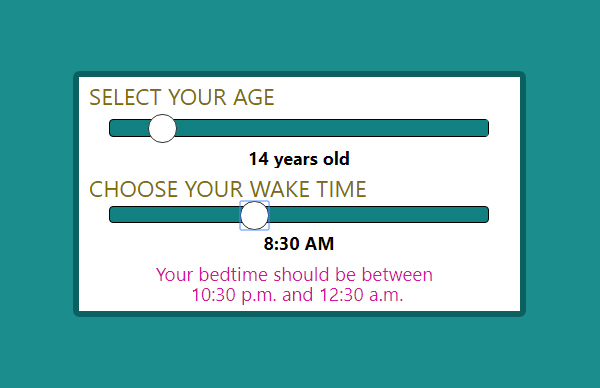DARIEN, IL – The arrival of another school year means that it’s time for students to reset their bedtimes as the summer break comes to an end. To help identify the appropriate bedtime for children, teens and adults, the National Healthy Sleep Awareness Project has created an online Bedtime Calculator. Project partners – including the American Academy of Sleep Medicine (AASM), the Centers for Disease Control and Prevention (CDC) and the Sleep Research Society (SRS) – developed the calculator as part of the “Make Time 2 Sleep” campaign to help families adopt routines that fit each individual’s unique lifestyle and sleep needs.
“Back-to-school time provides families with a perfect opportunity to re-evaluate their sleeping habits and establish healthy routines to ensure sufficient sleep,” said AASM President Dr. Ilene Rosen. “No matter the age, children and adults report improved alertness, energy, mood and physical well-being when enjoying healthy, consistent sleep.”
Personalized Bedtime Calculator
The online Bedtime Calculator allows schoolchildren, teens and parents of young children to enter an age and wake time to identify an appropriate bedtime based on the sleep duration recommendations of the American Academy of Sleep Medicine:
- Infants 4 months to 12 months new: 12 to 16 hours (including naps)
- Children 1 to 2 years new: 11 to 14 hours (including naps)
- Children 3 to 5 years new: 10 to 13 hours (including naps)
- Children 6 to 12 years new: nine to 12 hours per night.
- Teenagers 13 to 18 years new: eight to 10 hours per night
Because everyone needs sufficient sleep, adults also can use the Bedtime Calculator to help them get the recommended seven or more hours of nightly sleep.
Later School Start Times
During adolescence a natural shift occurs in the timing of the body’s internal circadian clock, causing most teens to have a biological preference for a late-night bedtime and later wake time. Early school start times can make it difficult for teens to get sufficient sleep, requiring them to adhere to an early bedtime that is unrealistic for their age.
A recent CDC analysis found that early school start times are prevalent, with only 17.7 percent of public middle schools and high schools in the U.S. starting school at 8:30 a.m. or later. CDC data also show that only 27 percent of U.S. high school students report sleeping 8 hours or more on an average school night.
The American Academy of Sleep Medicine asserts that the school day should begin at 8:30 a.m. or later for middle school and high school students. Later start times provide adolescents a better opportunity to get sufficient sleep on school nights, which helps to optimize their daytime alertness, reduce tardiness and improve school attendance. A later school start time supports peak academic performance, more opportunities for learning, better mental health and reduced risk of injury.
Later school start times also can reduce the risk of motor vehicle accidents, which account for 35 percent of all deaths and 73 percent of deaths from unintentional injury in teenagers. One study found that crash rates declined by 16.5 percent following a school start time delay of 60 minutes.
To help raise awareness and improve teen safety, the National Healthy Sleep Awareness Project has created a template letter for parents and community members to download from the “Make Time 2 Sleep” webpage. Parents are encouraged to send the letter to their local school boards and policy makers. The template letter, along with other information about healthy sleep, is available at www.projecthealthysleep.org.
CONTACT: Mary Velan, L.C. Williams & Associates, 312-565-4631, mvelan@lcwa.com.
About the National Healthy Sleep Awareness Project
The National Healthy Sleep Awareness Project was initiated in 2013 and is funded by the Centers for Disease Control and Prevention through a cooperative agreement with the American Academy of Sleep Medicine. The project involves collaboration with the Sleep Research Society and other partners to address the sleep health focus area of Healthy People 2020, which provides science-based, 10-year national objectives for improving the health of all Americans. The sleep health objectives are to increase the medical evaluation of people with symptoms of obstructive sleep apnea, reduce vehicular crashes due to drowsy driving and ensure more Americans get sufficient sleep. For more information, visit www.projecthealthysleep.org.





